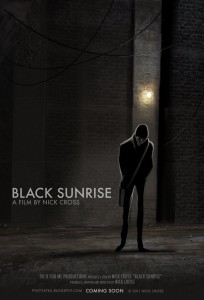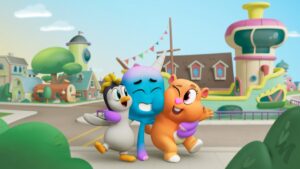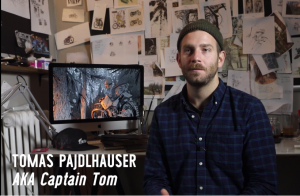
In anticipation of tonight’s premiere for the Clockwork Elves, I’m digging up some old interviews with Nick Cross and resharing. Here’s one from way back in 2011, when Nick was still living in Canada and had just started working on his feature project, Black Sunrise. If you’re interested in reading more, part 2 is here.
Mike
Back on April fourth, we reported filmmaker Nick Cross’ announcement that he was embarking on the production of his latest film, Black Sunrise. Regular readers will be familiar with Nick and his work, along with my clear and unabashed bias towards both. With Black Sunrise, he’s making a big jump, from short films to features. To that end, he’s launched a fundraising campaign via IndieGogo, the link to which is immediately to the left of this article.
Nick was good enough to take some time out of his day to chat with me about his development as an animator, his current project: Black Sunrise, and one Charlie Sheen reference. Here’s part one.
MV: You’ve been talking about a feature for a little while now, what’s your reasoning for making the jump?
NC: Yeah, I actually got the idea for doing a feature after the 2008 Ottawa International Animation Festival.
MV: What inspired you?
NC: I went to the Richard Williams seminar and he was talking about making features and how he is working on another film right now. I thought, jeez I should do that instead of doing shorts all the time. I think that “features” are more respected by people, and the industry in general, than shorts. I’ve gotten to a point now where I am pretty fast and have a streamlined production process, so I figured I should do it before I’m too old.
MV: You’ve had a good run with the short films, can we discuss the first?
NC: Sure.
MV: When I first met you, you were writing a novel, as I recall.
NC: Ha ha. I was doing that with a friend of mine, it sort of petered out.
MV: Something sci-fi, I think, right?
NC: Yeah, I always have some kind of project on the go, it seems.
MV: Yeah, that’s what I’m getting at. You were always doing some kind of creative project since before you got into animation, but you seemed to really find your medium with cartoons
NC: Well, animation sort of melds all of my interests into one. It’s like the perfect art form, for me anyway.
MV: Did you ever have that “moment” where this thing really clicked for you?
NC: I’m not sure, but definitely when I first saw Graham Falk‘s Untalkative Bunny short I got really inspired. When I found out that he had done it alone with Dan Craig doing the compositing on his computer, I realized how easy it really is. So I came up with a really simple idea and started animating it, and that was Tea for Two.
MV: I also remember a test you did, an anthropomorphic cat, pushing a stroller. Was that the first thing you ever animated?
NC: Yeah, I’m not sure when I did that exactly.
MV: It was before tea for 2.
NC: Yes, probably just a few months before I started on it. I wanted to see how hard it would be to animate something since a lot of the ‘old-timers’ at the studio made it seem impossible unless you went to school for it.
MV: Yeah, there was a bit of an “arcane knowledge” approach to it.
NC: I also did some test animation for Angora Napkin that I never shot, figuring out basic timing principles etc, like how to animate a character hitting a drum. Most of the principles of animation are pretty basic, like spacing and timing. It’s still pretty complex, but the basics are basic–I’m not sure how they are taught at animation school (maybe I better not keep going with this train of thought, ha ha)
MV: Yeah, that’s a whole other conversation.
NC: Yeah
MV: So from there, when did it click? You were doing the boring day job stuff, but all of a sudden, you just started making stuff. First with Tea For Two, and you just never stopped.
NC: Well, it wasn’t that boring of a day job. I was learning a lot doing layouts, but I still had a lot of free time and curiosity about it, so I just started making it…I didn’t even make a storyboard. I just took a clip of audio from (Ingmar Bergman’s)”The Seventh Seal” and animated to it with fake subtitles. I figured that doing a subtitled film would mean that it would divert the audience away from seeing the crappy animation because they were reading the text.
MV: And that’s the lesson of that film, and something I try to teach my students: you set out to make a film you could actually make, designing something do-able and accepting your limitations
NC: Yeah absolutely. Work within your abilities. It was only a minute long, with two characters sitting in chairs, since that meant I only had to move their arms and mouth. Basically kind of like a flash cartoon.
MV: I still use it as an example of economical film-making.
NC: Yeah it was certainly that.
MV: Most people try to make the film they’ve always wanted to make, whereas you keep making better films, that are within your capabilities. From there, there was “Maybe”, which is still my favourite project I’ve ever been involved in, but I’m sentimental like that.
NC: Yeah, that was kind of a crazy thing to do as a second film.
MV: It was ambitious.
NC: Yeah, definitely, but that’s also a good thing to do–to push yourself into the deep end and see if you can swim. I learned a lot doing that film. Mostly that was the film that made me want to do all the post production work myself from then on.
MV: yeah, there are a lot of names in the credits of that one.
NC: I realized that animation is only a part of the film making process and there is still a lot that can be done beyond that.
MV: And timing played into it a lot too. The technology was just starting to emerge that would enable you to take control of the process. Back then you needed these crazy expensive machines to do ink and paint. But all that changed.
NC: I was watching how they cut together animatics and realized that the same process could be used to make a film. Just take individual drawings, colour them in Photoshop and then edit them together in an editing program 2 frames at a time. So my next few films were done that way. It took a lot of time, but it saved on money.
MV: And gave you full control.
NC: And allowed me to play around with post production effects, etc.
MV: Red Scarf was next, right? Then U-girl?
NC: Yep, I started that right after Maybe was done, but it took a long time to do, so I did U-girl at the same time, with the intention of making something simple that I could start and finish in a month or two.
MV: It’s interesting, because after Maybe, you seemed to hit the reset button and start from scratch, artistically, going back to how animation got made in the early days.
NC: Well, around that time I was watching a lot of silent films and old cartoons so that influenced me a lot. I wanted to make something that looked like it had been found in an old vault somewhere instead of made on a computer.
MV: But was there a conscious choice in terms of educating yourself in the animation process as well? That back to basics approach?
NC: Sort of. I wish I’d done it more, but at the time it was really hard to find old cartoons. This was before the internet had any sort of video capabilities. So I couldn’t watch a ton of old Fleischer and Ub Iwerks cartoons to study them. I had to guess and figure it out from books. So U-girl especially looks a little stiff compared to what I wish it looked like if I’d had better resources. But that’s how you learn, by making mistakes.
MV: Right, by doing. And the next film is always better.
NC: Exactly. At least, that’s the hope.
MV: So what was next? U-girl, then… Mr Floaf?
NC: Then I finished red scarf, that was in 2001.
MV: Right, working concurrently, forgot.
NC: Yeah then I did Mr. Floaf to try and learn flash.
MV: Was that when you were working with John K?
NC: It was started just after working on the Untalkative Bunny series and during my short stint on the Ripping Friends. So there is an obvious change in look. My work got more loose and cartoony after doing all that board work on the Untalkative Bunny. And then I learned some cartooning principles from John K which helped it all come together.
MV: Working on the Bunny clearly connected with you. Do you want to discuss your influences? Starting with Graham Falk?
NC: He’s probably my biggest influence.
MV: You’d been kind of learning on your own up until then.
NC: Yeah for sure. He never directly taught me anything, but I learned by studying his work. John k was an influence, as he is on anyone that works for him. He is very good at distilling basic cartoon theories down and explaining them. Applying it to your work is another matter however. Not quite as easy. The biggest thing I learned from him was how to apply structure to a cartoon and still keep it loose.
MV: You sometimes get lumped in as a John K “type”.
NC: Well, that is understandable. People like to put labels on things. If you draw in an obsolete cartoon style, then you draw like John K.
MV: But it’s more about the language of cartoons. John draws from some pretty clear influences, and he imparts them. But it’s really a common language.
NC: Yes exactly. All of the Warners directors worked from the same set of rules but all their films look very different.
MV: But of a school, of a common language.
NC: Exactly.
MV: And that’s part of what, in my opinion, draws viewers into your films. It’s a language that’s familiar to us all.
NC: Now there is such a drive for ‘finding your own style’ which is really asinine. A style is something that comes naturally to an artist. If you like cartoons, and that’s how you naturally work, than that is how your ‘style’ will evolve. If you like realistic drawing, then your work will reflect that. If you try to copy another artist’s ‘style’ you end up just copying their mistakes. In a lot of ways, a style is a collection of an artist’s mistakes.
MV: So how do you avoid it?
NC: You can’t. You just have to keep pushing yourself to get better.
MV: Setting your own challenges.
NC: Yeah.
MV: Persephone really had that feeling to it. You were exploring something, wrestling with animation as a medium.
The Waif of Persephone from Nick Cross on Vimeo.
NC: Yeah it was tough, but that was the film where I think that I ‘graduated’ from animation school…where I think I cracked the animation code, so to speak, where all the principles started to make sense.
MV: It’s a gorgeous film, and you seemed really solid on your storytelling, your layouts and colour. And the animation seemed to be getting broken down and pushed at the same time. There’s an amazing ugliness to some of the cartooning. It really felt like some kind of giant struggle, you could see the process on the screen.
NC: Thanks. .that’s my favorite film that I’ve done in terms of story….artistically it’s still a little weak, but again, that’s how you learn. That was also the last film that I animated on paper.
MV: I miss paper. Studios feel weird without the chaos.
NC: Yeah, I do too sometimes…but it is a lot easier working digitally, and faster.
MV: You seem to have really embraced it, and it works well for you. Again, the timing: technology emerging to allow you the freedom to make these films.
NC: Yeah, because if you are working as an independent animator, it’s a really good idea to find as many ways as you can to save time without losing quality. I love that I don’t have to shoot tests anymore, what a pain that was.
MV: Now, at the same time, you started building a bit of a following. Your name started popping up in a few articles via John K and others, and you were doing your production blog for Persephone.
NC: Well, that was also just simply because of the internet making it easier to get your work seen, that’s why I started a blog.
MV: But that’s also played a huge role in your life as a film-maker.
NC: Yes and no…even without any of that I would still be making films. It’s nice that you know there are others out there that like what you are doing, but really I make films just because I love doing it.
MV: I wasn’t implying otherwise, it just seemed such a natural fit, as a means of putting your work out there. When you started, the only place to show your films was festivals.
NC: Yeah, and really very few people ever go to those, so your audience is pretty small.
MV: You had most of your older films archived on your website, what was the first one you released online using YouTube or Vimeo?
NC: I think it was Yellow Cake. I put it up before I entered it into festivals.
Yellow Cake from Nick Cross on Vimeo.
MV: And it got seen, pure and simple. The most direct approach: Make it. Share it.
NC: Yeah, it got a lot of views which was pretty surprising. It changed my outlook on distribution. I’ve kind of sworn off festivals now. It just costs too much time and money to do.
MV: What had been your idea about distribution previously?
NC: I didn’t have one. I would just enter the film into festivals and that was it… there wasn’t much else you could do until Youtube and Vimeo etc appeared on the scene. I tried selling DVD’s on my website for Waif of Persephone, but I didn’t sell very many copies.
MV: How did the Yellowcake t-shirts do?
NC: I think I sold one… it’s a tough racket!
MV: So all the while, supporting yourself doing boards and other small projects.
NC: People always ask me how they can make a living as an independent animator, I have to tell them to get a day job. It’s true though. If you really want to do it, you shouldn’t be counting on making a living at it…
MV: Coppola says the same thing, only his is a multimillion dollar winery.
NC: yeah, but he is right though. The budgets on animated features is insane. It’s possible to make a feature for almost no money now but it costs more for Disney to make a movie now than it did in the old days.
MV: look at Nelvana and Rock and Rule. That movie broke them. It would cost a fraction to make today.
NC: Exactly.
MV: Features used to be studio killers, but the cost to produce has actually scaled back to such a degree that they’re do-able again, if managed properly, outside the studio system.
NC: Yes but that’s the key. You don’t need studios anymore. At all.
MV: That’s what you run the risk of proving here, with Black Sunrise.
NC: The only problem I’m up against is the time it takes to make something, but if I was able to take a year off of commercial work I could make a feature in that time. It took me a month to do the trailer and that was in my spare time.
MV: So, you’re doing the funding campaign.
NC: Yeah…I’m also going to try to find other funding sources to see if it is possible. Like government grant agencies… I’ll see if it’s possible. Another reason for doing a feature is that it’s the only format that distributors look for and with a distributor comes Telefilm money etc
MV: Yeah, and with the “success” of films like Triplettes of Belleville, the Illusionist and Secret of the Kells, indie animated feature has some cachet right now. There are legit distributors that will actually take a meeting.
NC: Yeah, for sure.
MV: I’m going to be very direct here, but you’ve got as close to a perfect formula as I think is possible right now: an artist at the top of his game, with critical success and a history of delivering. You’ve got a built in following, the online fundraising model, plus technology that allows you freedom and minimizes cost. Also a market that is accepting of different forms of animation than, say, a decade ago.
NC: The only problem with the online fundraising is that it’s still pretty hard to raise enough funds to finance a film…especially by an independent. Let’s be honest: the reality is if Charlie Sheen were to say he was making an animated film, he would be able to raise far more money than I ever could. That’s what independent filmmakers are up against.
MV: Yeah, but I think we’re at some kind of tipping point, at least in Canada. We posted a YouTube video a while back, “So you want to make a Canadian Cartoon”, it puts it very plainly, the challenge of making a cartoon in Canada.
NC: Yes, for sure.
MV: The next thing I posted was your announcement, the following Monday morning. What you’re doing is a solution. Your solution, at least, but I think it’s a viable one. Not everyone will be able to do it, but you run the risk of showing it’s possible, because let’s be honest, you’re going to make this film, one way or the other.
NC: Yeah, I hope so. I mean I’m not the first person to make a feature by themselves- Bill Plympton and Nina Paley have done it.
MV: That’s pretty good company. But you’re the only one doing it around here.
NC: Yeah, I think it’s going to become more common in the next few years.
MV: The right film makers can do it. It was impossible just a few years ago.
NC: Absolutely. It’s still hard now, but at least the technology is there to help make it possible.
MV: And it might be possible to make a sustainable living doing it. Animation offers the opportunity to do this as a one man operation in ways that live action just can’t. And while live action is more immediate, it’s intrinsically more collaborative.
NC: For sure
MV: You don’t have to depend on anyone else to make your film, which is freedom.
NC: One computer is all the collaboration you need.
A good spot to stop. I’ll get some more from Nick soon. In the meantime, hit the link to the Black Sunrise IndieGogo campaign, skip tomorrow’s latte, and help support independent animation.
mv
Black Sunrise – Trailer from Nick Cross on Vimeo.









Be First to Comment